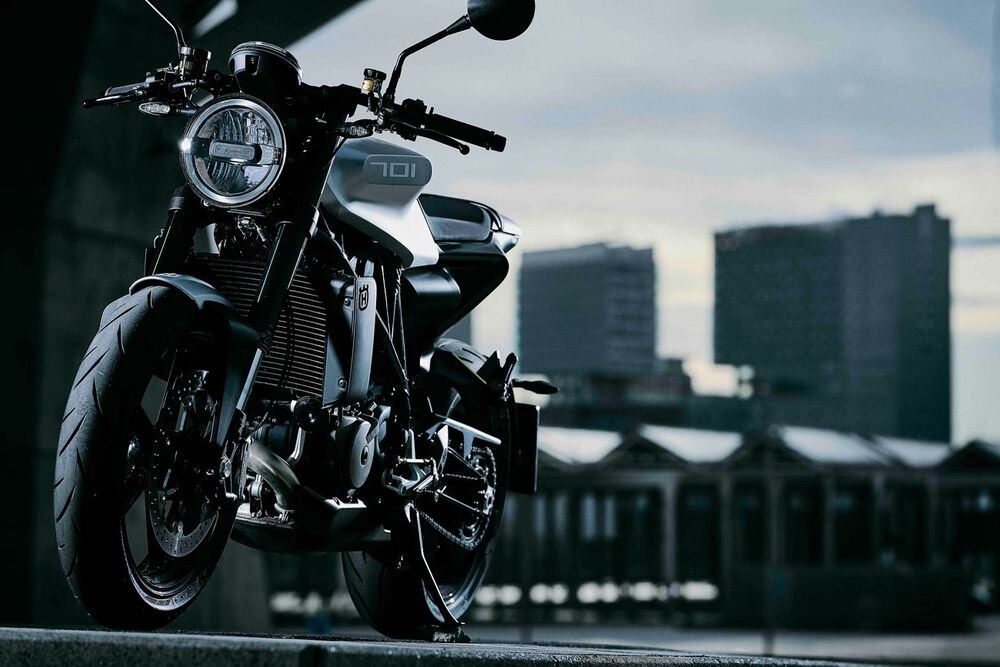Motorcycles run in Justin Maxwell’s family. His father worked as motorcycle mechanic in his native South Africa, and Maxwell spent his youth racing motocross, eventually ascending to the national level. After attaining degrees in marketing and business management, Maxwell secured a job that kept him close to two wheels, serving as the sales and marketing lead at South Africa’s largest KTM dealership in Johannesburg. From there, Maxwell moved to Mattighofen, Austria, to act as a project manager for Husqvarna. His tenure began just as the Vitpilen 701 concept was born, so he’s been with the model since its inception. We caught up with Maxwell at the press introduction for the Vitpilen 701 in Barcelona, Spain, to gather some insights into this unique model’s design and development. It feels like we’ve been waiting for this bike forever, but it actually went from concept to production very quickly. How? Yes. We only showed the concept of the Vitpilen 701 in 2015, so the project was actually fast-tracked. We were eager to get Husqvarna back into the street segment with a full street motorcycle, and by using the 690 frame and engine, we didn’t have to develop a frame from scratch or an engine from scratch. So then the main challenge was the design, to get all the bodywork to fit correctly and look right. Husqvarna’s parent company, KTM, has some production facilities in India. Is the Vitpilen made in Asia? It’s made in Austria. Of course there are parts sourced from other countries, like say, the throttle body is from Japan, but we manufacture and assemble bikes in a shared facility with KTM in Austria. Both production lines are under the same roof.
New models don't just materialize out of thin air, so what sort of testing was conducted to ensure the Vitpilen performed as intended?
We had four different prototypes and various raw interpretations up to the version just before serial production, so in all we worked with about 30 variations of the bike. Our testing includes riding on European public roads, city riding, and closed-course testing. Each model is durability tested to 50,000 kilometers, but if you factor in all the tire tests, suspension test, handling tests, ABS application, etc., we probably have a few hundred thousand kilometers of development time on the Vitpilen. We also do benchmark testing against competing models, which in this case included the Ducati Monster 821 and Scramblers, BMW R nineT, Yamaha MT-07 and MT-09 and XSR models, Triumph Street Triple, and MV Agusta Brutale.
It seems as though the Vitpilen's "Simple. Progressive." design ethos would have made it a perfect candidate for a TFT dash and keyless ignition. Why not include those features?
As with every development we had some limitations, and the TFT dash and keyless ignition are some sacrifices we had to make to meet our timing and budget requirements. We also considered putting the key at the front of the tank, but that would have made it harder to tie into the wiring harness behind the headlight. TFT and keyless ignition would have been good, but what we have currently fits the simplicity we strive for in the Vitpilen. We could look at incorporating these features where possible in the future.
The Vitpilen uses the Duke 690's engine. Are the frame and swingarm taken from the KTM as well?
The chassis is basically the same, the geometry and that's the same, but we made some small adjustments for the fuel tank mounting and the subframe mounting. The rake and trail are different as well, but that's based on the triple clamp.
Related Video: 2018 Husqvarna Vitpilen 701 Ridden And Reviewed
Husqvarna is touting the Vitpilen's engine as the most advanced single on the market. What is that based on?
A lot of it has to do with the electronics that are connected to it, like the ride-by-wire throttle, quickshifter, and auto-blip. It's also the highest-performing single we have at the moment, yet it has 10,000-kilometer service intervals, which for a single is very long. Then there's the weight [96 pounds] and compactness of it, and mechanical features like dual counterbalance shafts, one to counter the crank force and one to counter the camshaft force. A lot of development went into this engine, and it has features and performance not found anywhere else in the market.
What was the most challenging aspect of developing this bike and bringing it to market?
The main thing was getting the design on point. Building it the same way we presented it as a concept bike and not as some watered-down version was probably the biggest challenge. At the same time making sure it performs well and is fun to ride and isn't just one of these design bikes that look good but sacrifice a lot of function. It had to stick to our values at Husqvarna, so that means performing well.
What was the most satisfying aspect of the project?
Having it handle and perform as well as it does. We've built a good-looking motorcycle that performs well and puts a smile on your face. Getting that combination is something I'm proud of.











/cloudfront-us-east-1.images.arcpublishing.com/octane/JH3OLC2Y7SIAD5IOHDQLRR4CPY.jpg)

/cloudfront-us-east-1.images.arcpublishing.com/octane/MUQLOVLL2ZDGFH25ILABNBXKTI.jpg)
/cloudfront-us-east-1.images.arcpublishing.com/octane/TNOU5DNE2BC57MFPMGN2EIDXAM.jpg)
/cloudfront-us-east-1.images.arcpublishing.com/octane/GTCXACQGJ5HAPDTGWUQKDEH44E.jpg)
/cloudfront-us-east-1.images.arcpublishing.com/octane/S35YGSEMEZB4BLTDJTSZPF4GLA.jpg)
/cloudfront-us-east-1.images.arcpublishing.com/octane/5UOT6HPX2JFMRJAX6EH45AR4MQ.jpg)
/cloudfront-us-east-1.images.arcpublishing.com/octane/OKWOJWAKP5EP3OACCRRWPCIX2Q.jpg)
/cloudfront-us-east-1.images.arcpublishing.com/octane/2WF3SCE3NFBQXLDNJM7KMXA45E.jpg)
/cloudfront-us-east-1.images.arcpublishing.com/octane/G4MG6OUCJNBSHIS2MVVOTPX65E.jpg)
/cloudfront-us-east-1.images.arcpublishing.com/octane/IIGGWFOTOJGB7DB6DGBXCCMTDY.jpg)
/cloudfront-us-east-1.images.arcpublishing.com/octane/QSTCM6AVEZA5JJBUXNIQ3DSOF4.jpg)
/cloudfront-us-east-1.images.arcpublishing.com/octane/U4I7G625B5DMLF2DVIJDFZVV6M.jpg)
/cloudfront-us-east-1.images.arcpublishing.com/octane/B6XD6LS6IVCQPIU6HXDJSM3FHY.jpg)
/cloudfront-us-east-1.images.arcpublishing.com/octane/ICL63FEDDRDTTMINYICCEYGMDA.jpg)
/cloudfront-us-east-1.images.arcpublishing.com/octane/FCGZHQXRBZFLBAPC5SDIQLVF4I.jpg)
/cloudfront-us-east-1.images.arcpublishing.com/octane/WNOB6LDOIFFHJKPSVIWDYUGOPM.jpg)

/cloudfront-us-east-1.images.arcpublishing.com/octane/X33NU3E525ECRHXLNUJN2FTRKI.jpg)
/cloudfront-us-east-1.images.arcpublishing.com/octane/6KKT5NNL2JAVBOXMZYS5ZO76YA.jpg)
/cloudfront-us-east-1.images.arcpublishing.com/octane/J5RKG5O455GMPGQRF2OG6LRT7A.jpg)
/cloudfront-us-east-1.images.arcpublishing.com/octane/GX2CIZKQVRH2TATDM26KFG2DAE.jpg)
/cloudfront-us-east-1.images.arcpublishing.com/octane/ZWIDYSAKQZHD5BHREMQILXJCGM.jpg)
/cloudfront-us-east-1.images.arcpublishing.com/octane/CYUHJZCTSJCH3MRAQEIKXK7SCQ.jpg)
/cloudfront-us-east-1.images.arcpublishing.com/octane/LKOFINY56FCXJCANJ5M7ZDQUBY.jpg)
/cloudfront-us-east-1.images.arcpublishing.com/octane/4NBPDACMWJH63JQYJVK3QRBDZI.jpg)